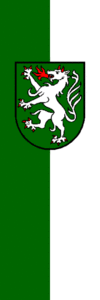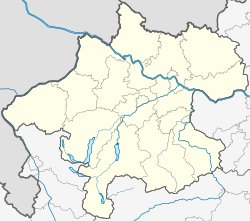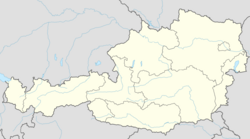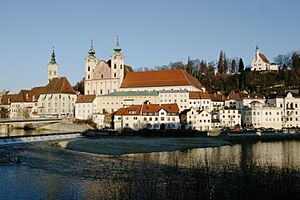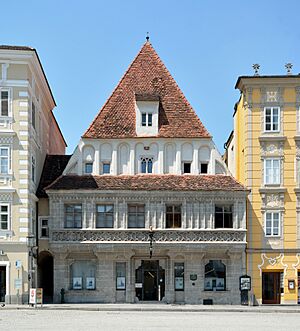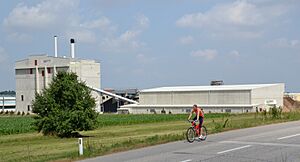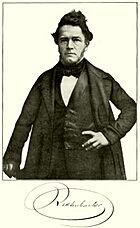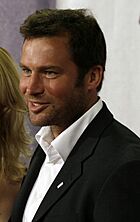Steyr facts for kids
Quick facts for kids
Steyr
Steia
|
|||
|---|---|---|---|

View over the Old Town with city hall and parish church
|
|||
|
|||
| Country | |||
| State | |||
| District | Statutory city | ||
| Area | |||
| • Total | 26.56 km2 (10.25 sq mi) | ||
| Elevation | 310 m (1,020 ft) | ||
| Time zone | UTC+1 (CET) | ||
| • Summer (DST) | UTC+2 (CEST) | ||
| Postal code |
4400
|
||
| Area code | 07252 | ||
| Vehicle registration | SR | ||
| Website | www.steyr.at | ||
Steyr (pronounced SHTY-er) is an important city in Upper Austria, a state in Austria. It is a "statutory city," meaning it has its own special government. Steyr is the 12th largest town in Austria and the 3rd largest in Upper Austria.
This city has a long history of making things, especially in factories. Some famous companies, like Steyr Motors, got their start here.
Contents
Geography and Location
Steyr is located in a region called Traunviertel. Two rivers, the Steyr and the Enns, flow through the city. They meet near the city center, close to Lamberg Castle and St. Michael's Church.
Because of its location near these rivers, Steyr has sometimes had serious floods. One of the worst floods happened in August 2002. South of the city, there are hills that lead up to the Upper Austrian Prealps. To the north, the land slopes down towards where the Enns River meets the Danube River. The city of Enns is located there. To the east, Steyr borders Lower Austria.
Steyr is a very old city, but it also has modern facilities. It is known for its rich culture and beautiful old buildings. Like Vienna, Steyr attracts tourists who want to see its well-preserved historic areas. The city celebrated its 1,000th birthday in 1980. Many of its old buildings were carefully fixed up, making it one of the best-preserved old towns in Austria.
The famous historic city center is built around the Stadtplatz (which means "town square"). It was mostly rebuilt after World War II. The most famous building there is called the Bummerlhaus. It is a great example of Gothic architecture in Central Europe.
The city is made up of several smaller areas called cadastral communities. These include Christkindl, Föhrenschacherl, Gleink, Hinterberg, Jägerberg, Sarning, Stein, and Steyr.
History of Steyr
People called Celts first settled in this area around 600 BC. The name of the Steyr River comes from the Celtic language. Later, their kingdom became part of the Roman Empire in 15 BC. An ancient Roman road, called the "Iron Road," passed through this region. It was used to transport iron from the Erzberg mine.
In the 6th century, Slavic people moved into the area. But later, in 777, the land was given to a nearby monastery. This led to Bavarians settling there. During times of invasion, a fortress was built above the Steyr River. This fortress, called Styraburg, was first mentioned in a document from 980.
From 1055, Steyr Castle and the nearby region were ruled by the powerful Otakar family. They controlled the iron mining at Erzberg. Steyr became an important center for medieval culture and poetry. In 1180, Emperor Frederick Barbarossa made Ottokar IV a duke. However, the Otakar family line ended in 1192. Their lands then went to the Babenberg dukes of Austria.
Steyr was already a town by then. It lost its role as a duke's home but remained important for ironworking. The Babenberg rulers helped its economy grow. Steyr became known for blacksmithing, especially making knives and weapons. After the Babenberg family ended in 1246, Steyr was taken over by King Ottokar II of Bohemia. Later, King Rudolf I of Germany of the Habsburg family took control after a battle in 1278.
King Albert I, Rudolf's son, confirmed Steyr's town rights in 1287. The people of Steyr benefited from its good location for iron trade. This trade was important throughout the Holy Roman Empire and with the Republic of Venice.
In the 13th and 14th centuries, Steyr was a center for the Christian Waldensian movement. This led to persecutions by the Catholic Church. Later, the Protestant Reformation spread quickly in Steyr around 1525. The Habsburg rulers strongly opposed this during the Counter-Reformation.
The city's economy suffered during the Thirty Years' War. Upper Austria was given to Duke Maximilian I of Bavaria. There was also a Peasants' War in Upper Austria in 1626. In 1727, the old Styraburg castle was destroyed by a fire. It was replaced by the Baroque Lamberg Castle. Steyr began to recover in the late 1700s and grew during the industrialisation. During the Napoleonic Wars, French troops occupied Steyr several times. An agreement called the Armistice of Steyr was signed there on December 25, 1800.
In 1830, a blacksmith named Leopold Werndl started an armory in Steyr. His sons, Josef and Franz Werndl, turned it into a company in 1864. It was called Österreichische Waffenfabriksgesellschaft (ÖWG). Later, it became Steyr-Werke AG in 1926 and grew into a large industrial group. However, Steyr's industries were badly affected by the Great Depression in 1929.
In 1934, Steyr was one of the places where fighting occurred during the Austrian Civil War. This conflict led to a new government in Austria. In 1938, Austria became part of Nazi Germany. The Nazi government took over the arms industry in Steyr. They built a subcamp for forced laborers, which was part of the Mauthausen camp network.
During World War II, Steyr was a major producer of weapons and military vehicles. Because of this, it became a target for bombing raids by the Allies. In February 1944, American forces bombed the city. Much of the town was damaged, but the factories kept working until near the end of the war.
On May 9, 1945, soldiers from the Soviet Army and the US Army met in Steyr on the bridge over the Enns River. The US Army occupied Steyr. The Soviet Army moved east. The troops stayed until 1955, when Austria declared itself neutral.
Population of Steyr
| Largest groups of foreign residents | |
| Nationality | Population (2014) |
|---|---|
| 1,524 | |
| 879 | |
| 580 | |
| 385 | |
| 334 | |
| Historical population | ||
|---|---|---|
| Year | Pop. | ±% |
| 1869 | 16,593 | — |
| 1880 | 21,054 | +26.9% |
| 1890 | 26,139 | +24.2% |
| 1900 | 22,272 | −14.8% |
| 1910 | 22,205 | −0.3% |
| 1923 | 27,200 | +22.5% |
| 1934 | 25,351 | −6.8% |
| 1939 | 31,017 | +22.4% |
| 1951 | 36,818 | +18.7% |
| 1961 | 38,306 | +4.0% |
| 1971 | 40,822 | +6.6% |
| 1981 | 38,942 | −4.6% |
| 1991 | 39,337 | +1.0% |
| 2001 | 39,340 | +0.0% |
| 2011 | 38,313 | −2.6% |
| 2014 | 38,273 | −0.1% |
Steyr is home to many people from different countries. The table shows the largest groups of foreign residents in 2014.
Local Government
The local council, called the Gemeinderat, has 36 members. In the 2015 elections, the results were:
- SPÖ (Social Democratic Party of Austria): 16 seats
- FPÖ (Freedom Party of Austria): 10 seats
- ÖVP (Austrian People's Party): 5 seats
- The Greens: 4 seats
- NEOS: 1 seat
Economy and Industry
The main industry in Steyr is making parts for cars. Some of the most important companies in Steyr are:
- BMW Motors
- GFM Steyr GmbH
- MAN
- NKE AUSTRIA GmbH
- Profactor
- SKF
- Steyr Motors
- ZF Steyr
Other important Austrian companies in Steyr include:
- AVL List
- Eckelt Glass GmbH
- Hartlauer
- Steyr-Mannlicher
City Infrastructure
Energy Supply
Steyr has a special heating system for the city. It provides most buildings and factories with clean, renewable energy. This heat comes from the Steyr biomass heating plant.
Sports in Steyr
The city's professional football (soccer) team is SK Vorwärts Steyr. They play their games at the Vorwärts Stadium.
Famous People from Steyr
Many well-known people have lived in or visited Steyr.
- Franz Schubert (1797–1828), a famous composer, wrote his "Trout Quintet" here in 1819.
- Anton Bruckner (1824–1896), another composer, was an organist at the local church.
- Young Adolf Hitler briefly attended secondary school in Steyr in 1904.
Other notable people from Steyr include:
- Johannes Stabius (c. 1460–1522), a mapmaker.
- Ferdinand Redtenbacher (1809–1863), an engineer who helped start science-based mechanical engineering.
- Josef Werndl (1831–1889), an arms maker, engineer, and inventor.
- Franz Schausberger (born 1950), a politician who was governor of Salzburg.
- Erich Hackl (born 1954), a novelist.
- Wilhelm Molterer (born 1955), a politician.
Sports Figures
- Helmut Köglberger (1946-2018), a footballer who played many games for Austria.
- Hannes Trinkl (born 1968), a former alpine skier and Olympic medalist.
- Stella Staudinger (born 1972), a former professional basketball player.
- Ronald Brunmayr (born 1975), a football player.
- Kevin Stöger (born 1993), a football player.
Sister Cities
Steyr has "sister city" relationships with other cities around the world. This helps promote cultural exchange and friendship. Steyr is twinned with:
See also
 In Spanish: Steyr para niños
In Spanish: Steyr para niños


